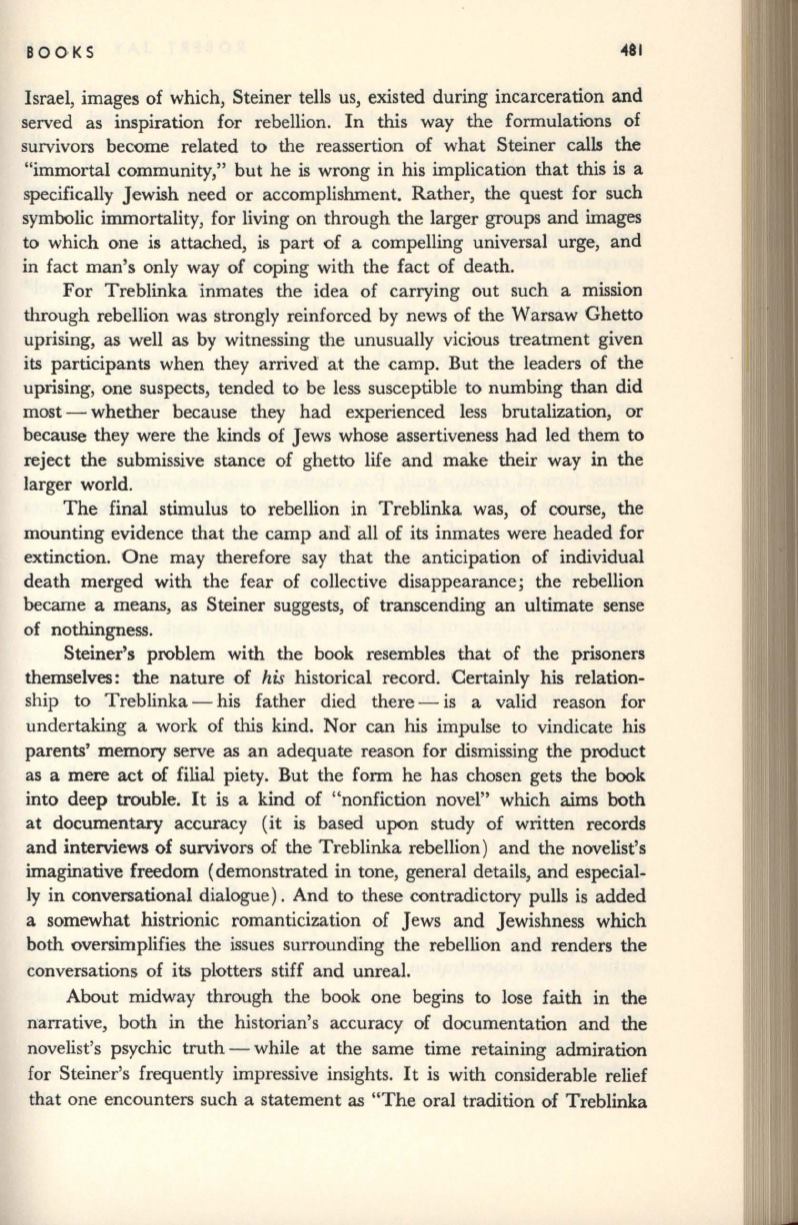
BOOKS
481
Israel, images of which, Steiner tells us, existed during incarceration and
served as inspiration for rebellion. In this way the fonnulations of
survivors become related to the reassertion of what Steiner calis the
"immortal community," but he is wrong in his implication that this is a
specifically Jewish need or accomplishment. Rather, the quest for such
symbolic immortality, for living on through the larger groups and images
to which one is attached, is part of a compelling universal urge, and
in fact man's only way of coping with the fact of death.
For Treblinka inmates the idea of carrying out such a mission
through rebellion was strongly reinforced by news of the Warsaw Ghetto
uprising, as well as by witnessing the unusually vicious treatment given
its participants when they arrived at the camp. But the leaders of the
uprising, one suspects, tended to be less susceptible to numbing than did
most - whether because they had experienced less brutalization, or
because they were the kinds of Jews whose assertiveness had led them to
reject the submissive stance of ghetto life and make their way in the
larger world.
The final stimulus to rebellion in Treblinka was, of course, the
mounting evidence that the camp and all of its inmates were headed for
extinction. One may therefore say that the anticipation of individual
death merged with the fear of collective disappearance; the rebellion
became a means, as Steiner suggests, of transcending an ultimate sense
of nothingness.
Steiner's problem with the book resembles that of the prisoners
themselves: the nature of
his
historical record. Certainly his relation–
ship to Treblinka - his father died there - is a valid reason for
undertaking a work of this kind. Nor can his impulse to vindicate his
parents' memory serve as an adequate reason for dismissing the product
as a mere act of filial piety. But the fonn he has chosen gets the book
into deep trouble.
It
is a kind of "nonfiction novel" which aims both
at documentary accuracy (it is based upon study of written records
and interviews of survivors of the Treblinka rebellion) and the novelist's
imaginative freedom (demonstrated in tone, general details, and especial–
ly in conversational dialogue). And to these contradictory pulls is added
a somewhat histrionic romanticization of Jews and Jewishness which
both oversimplifies the issues surrounding the rebellion and renders the
conversations of its plotters stiff and unreal.
About midway through the book one begins to lose faith in the
narrative, both in the historian's accuracy of documentation and the
novelist's psychic truth - while at the same time retaining admiration
for Steiner's frequently impressive insights.
It
is with considerable relief
that one encounters such a statement as "The oral tradition of Treblinka


